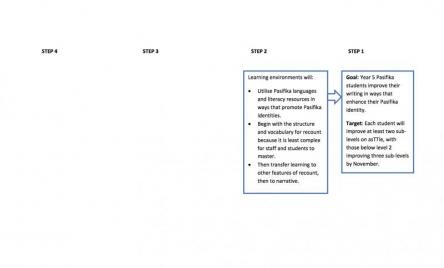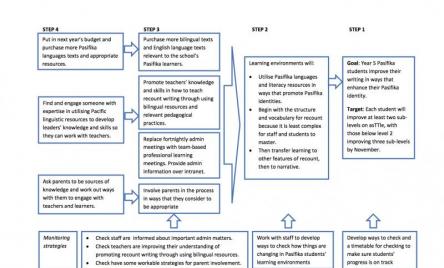Developing a theory for improvement
A guide on mapping out an evidence-informed story about the strategies you will use to get to your goal.
This page is based on the work of Helen Timperley for Spiral of inquiry: Leaders leading learning. In that resource, we suggest developing a theory for improvement in the Developing a hunch phase of the spiral.
What is a theory for improvement

A theory for improvement is a set of linked ideas about how to improve some aspect of what is happening in your school for your learners. This learner-related improvement is usually expressed as a goal.
The point of developing a theory for improvement is to get everyone onto the same page about the strategies you have decided collectively will achieve your goal and the reasoning that underpins those particular strategies – why these and not others.
Most theories for improvement identify:
- Your long term outcomes and annual goal – usually expressed as a measurable target.
- Proposed strategies to reach the target – usually staged because some things need to be in place before other things can happen.
- Why those strategies and not others.
- Ways to monitor whether you are making progress towards the goal.
Mapping your theory
The example we use here is based on Pasifika learners improving their writing in ways that enhance their Pasifika identity.
The example map is relatively simple for reasons of space. Most maps have arrows going all over the place.
Step 1
Begin with the end in mind. Put your goal on the right hand side of the paper with the target underneath.
Step 2
Describe what will be different in the school, teaching and learning environments and write this to the left of the goal with an arrow connecting the two boxes.
[In this example, the reasoning for beginning with the structure and vocabulary of a recount is that learning something deeply, then transferring that learning, is more consistent with what is known about learning than learning many things superficially. ]
Step 3
Decide what needs to change for the learning environments to reflect this picture. This may include aspects such as:
- purchasing more bilingual texts and English language texts relevant to the school’s Pasifika learners
- promoting teachers’ knowledge and skills in how to teach recount writing through using bilingual resources and pedagogical practices.
Step 4
Decide on the changes that need to happen for step 3 to happen. These may include:
- engaging someone with expertise in utilising Pasifika linguistic resources to develop leaders’ knowledge and skills so they can work with teachers
- engaging parents as sources of knowledge.
Step 5
Decide what you have to stop doing in order for this all to happen without overloading yourselves, teachers and learners. Often schools stop administration meetings in order to create the time for professional learning meetings.
Next
There may be many more steps or other things that have to happen concurrently. Put them into the map for your theory for improvement. Most maps look far messier than the one above.
You can use your theory for improvement to decide what you need to monitor to make sure you are on track to make enough of a difference.
You could work out with the teachers and students how to monitor whether the learning environment does reflect the identified priorities.
Refining your theory
You should expect your theory for improvement to change and evolve. Your initial theory sets your direction and defines the thinking underpinning it. As you progress, you will more fully understand the outcomes and processes.
You should regularly and rigorously revisit your theory for improvement, documenting your progress and decisions over time. This will build your understanding of what works, under what circumstances.
The activities in your theory provide some natural places to pause, consider evidence and emerging patterns, reflect and rethink the plan.
Case study
How evaluative practice and theories for improvement are setting the direction for the Rotorua Central Community of Learning, Kāhui Ako.
Originally published on the Enabling e-learning website. See:
Rotorua Central Commmunity of Learning | Kāhui Ako
References
Timperley, H. (2016). Developing a theory for improvement.
Theory for improvement (Word 2007 59 kB)
Earl, L. and H. Timperley (2015). Evaluative thinking for successful educational innovation. OECD Education Working Papers, No. 122. OECD Publishing, Paris. http://dx.doi.org/10.1787/5jrxtk1jtdwf-en
Photo: Mental by John Hain, CC0 1.0, retrieved from Pixabay
Related reading
Center for Educational Leadership, University of Washington. (2014). Creating a theory of action for improving teaching and learning. Available for download at http://info.k-12leadership.org/creating-a-theory-of-action
A guide to support principals to identify the leadership skills they need to develop, to improve teaching and learning in their school.


